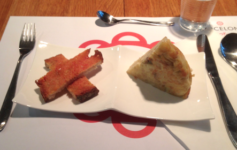Linen should not be dried too much by tumble drying, and it is much easier to iron when damp. Castor oil is obtained from . Flax plants for fiber are harvested in approximately 90-100 days. Linen can degrade in a few weeks when buried in soil. Fibres are the sclerenchyma cells that are associated with the vascular tissues and are a component of plant skeleton. [18] The linen on this mummy is also in a perfect state of preservation. The collective term "linens" is still often used generically to describe a class of woven or knitted bed, bath, table and kitchen textiles traditionally made of flax-based linen but today made from a variety of fibers. II. [31] Through the 1830s, most farmers in the northern United States continued to grow flax for linen to be used for the family's clothing. Plants including cotton, jute, flax and hemp are used to obtain plant fibres. Fine white linen is also worn by angels in the New Testament (Revelation 15:6). The different sources of plant fibres are- cotton, jute, coir, hemp and the flax. Linen fabric feels cool to touch, a phenomenon which indicates its higher conductivity (the same principle that makes metals feel "cold"). The word linen is of West Germanic origin[3] and cognate to the Latin name for the flax plant, linum, and the earlier Greek λινόν (linón). • Flax fibers give linen that is considered to be a royal fabric much older than wool and cotton. In the next post on the Linen Craft series we have a look at the following step: scutching and hackling. This is the number of 840 yard lengths in a pound. Due to its strength, in the Middle Ages linen was used for shields, gambesons, and bowstrings; in classical antiquity it was used to make a type of body armour, referred to as a linothorax. Since all plant fibers are made up of mainly cellulose, they are categorized as “natural cellulosic fibers”, which may consist of one plant cell or an aggregate of cells cemented together by non-cellulose materials. Though flax has lost some of its value as a commercial fibre crop owing… There is no explanation for this in the Torah itself and it is categorized as a type of law known as chukim, a statute beyond man's ability to comprehend. There are 15 questions in this test with each question having around four answer choices. Linen is used for making bed sheets. [17] When the tomb of the Pharaoh Ramses II, who died in 1213 BC, was discovered in 1881, the linen wrappings were in a state of perfect preservation after more than 3000 years. There are two varieties: shorter tow fibers used for coarser fabrics and longer line fibers used for finer fabrics. [citation needed], In 2018, according to the United Nations' repository of official international trade statistics, China was the top exporter of woven linen fabrics by trade value, with a reported $732.3 million in exports; Italy ($173.0 million), Belgium ($68.9 million) and the United Kingdom ($51.7 million) were also major exporters. 13. In the past, slubs were traditionally considered to be defects, and were associated with low-quality linen. Plant fibres are obtained from various parts of plants, such as the seeds (cotton, kapok, milkweed), stems (flax, jute, hemp, ramie, kenaf, nettle, bamboo), and leaves (sisal, manila, abaca), fruit (coir) and other grass fibres. Flax is also a plant that gives natural fibres. Answer: The jute plant is normally harvested at flowering stage. Flax. Noun (es) A plant of the genus Linum , especially , which has a single, slender stalk, about a foot and a half high, with blue flowers.Also known as linseed, especially when referring to the seeds. The Jewish Primer, by Shmuel Himelstein. For maximum emergence, flax requires a well prepared, firm and moist seedbed. In addition, slubs do not compromise the integrity of the fabric, and therefore they are not viewed as a defect. An alternate production method is known as “cottonizing” which is quicker and requires less equipment. Plant fibre is composed mainly of cellulose and cellulose fibres are most commonly used to make paper and cloth. When the Edict of Nantes was revoked in 1685, many of the Huguenots who fled France settled in the British Isles and elsewhere. Flax: Like cotton, flax fibre is a cellulose polymer, but its structure is more crystalline, making it stronger, crisper and stiffer to handle, and more easily wrinkled.Flax fibres range in length up to 90 cm, and average 12 to 16 microns in diameter. After retting, the stalks are ready for scutching, which takes place between August and December. Naturally obtained fibres come from plant and animal both.For example we get jute from plant while wool is an animal product. The fine yarns used in handkerchiefs, etc. Next the fibers are heckled: the short fibers are separated with heckling combs by 'combing' them away, to leave behind only the long, soft flax fibers. a. Hemp plant b. Flax plant c. Cotton plant d. Jute plant 4. Flax fiber is obtained from the inner bark of the stem of a plant grown in temperate and subtropical regions of the world. Typically, flax yields an average of 500-1,000 kg/ha. Answer: Some of these fabrics, woven from hand-spun yarns, were very fine for their day, but are coarse compared with modern linen. However, the very finest linen has very consistent diameter threads, with no slubs at all. Abstract. List some qualities of jute. 3. In England and then in Germany, industrialization and machine production replaced manual work and production moved from the home to new factories. Latin meaning is “the most useful.” Flax is a herbaceous annual which grows to about 1 metre in height in 3-4 months, and has attractive flowers, usually blue but can be … Some examples of the plant fibres are given below: 1. Like Jute, Flax fibre is obtained from the stem of the Flax plant. 6. (c) The cotton picked up from the plants still has its seed in it. The Lower Rhine was a center of linen making in the Middle Ages. A) done clear. Answer: c. Linen. • Flax fibers give linen that is considered to be a royal fabric much older than wool and cotton. 4. In Europe, however, linen is usually the only fabric support available in art shops; in the UK both are freely available with cotton being cheaper. Cotton and jute b. Coir and wool c. Wool and silk d. None of these 5. Linen is also mentioned in the Bible in Proverbs 31, a passage describing a noble wife. • Flax is a plant while linen is the fabric made from the fibers of the flax plant obtained from its stem. ; It is a food and fiber crop that is grown in cooler regions of the world. Linen fibres are obtained from the inner bark (or skin) of a plant. Thompson, 1995). This word history has given rise to a number of other terms in English, most notably line, from the use of a linen (flax) thread to determine a straight line. a) Sesamum indicum. (c) Cotton fibre is fibre which is obtained from the leaves of the cotton plant. Linen is relatively easy to take care of, since it resists dirt and stains, has no lint or pilling tendency, and can be dry-cleaned, machine-washed, or steamed. The fibers of Linum usitatissimum , grown to make linen and related textiles. 5. Flax fibre is obtained by stripping the bark or “bast fibres” from the stem of the linseed plant. B) Flax fibres are obtained from the stems of the plant Linum usitatissimum. This is a specific length therefore an indirect measurement of the fineness of the linen, i.e., the number of length units per unit mass. – 1 – 1 claSSification fibre flax, linseed and linolatm refer to the same plant, Linum usitatis- simum, which belongs to the linaceae family. Cotton fibres are up to 95 percent pure cellulose and derive from. Technically, linen is a vegetable. Which of the following do we get from plant? Linen was used in ancient civilizations including Mesopotamia[2] and ancient Egypt, and linen is mentioned in the Bible. [24], Linen continued to be valued for garments in the 16th century[25] and beyond. After two or three years of a flax crop, a farmer needed to sow a less nutritionally-demanding crop, such as wheat. This is a process which uses bacteria to decompose the pectin that binds the fibers together. State whether ‘True’ or ‘False’ (a) Wool is a synthetic fibre. Question 1. Animal fibres:- These fibres are obtained from animal sources, eg, wool is obtained from the fleece(hair) of sheep, goat, rabbit etc and silk is obtained from silkworm.Animal fibres … [14] Plutarch wrote that the priests of Isis also wore linen because of its purity. After flowering, the whole plant is pulled to obtain the maximum length of fibre. Linen is preferred to cotton for its strength, durability and archival integrity. [23], Textiles, primarily linen and wool, were produced in decentralized home weaving mills. Textiles in a linen weave texture, even when made of cotton, hemp, or other non-flax fibers, are also loosely referred to as "linen". Flax fibers vary in length from about 25 to 150 mm (1 to 6 in) and average 12–16 micrometers in diameter. The direct result of his good work was the establishment, under statute, of the Board of Trustees of the Linen Manufacturers of Ireland in the year 1711. c) roots. At one time it was the country's greatest export item and Russia produced about 80% of the world's fiber flax crop. It is a natural, cellulosic, multi-cellular bast fiber. The fine, light-colored textile fiber obtained from this plant. Answer: Wool is obtained from the fleece (hair) of sheep, goat, yak, etc. Wool is obtained from the fleece of sheep or goat. Douglas Harper, Historian. Fibers are remarkable for their great tensile strength, length of staple, fineness and durability. Known as a couche, the flax cloth is used to hold the dough into shape while in the final rise, just before baking. Everything You Need to Know About Using and Caring for Linen", "How quickly do fashion materials biodegrade? [41] Conversely, some brands such as 100% Capri specially treat the linen to look like denim.[42]. (d) Patsun plant is used to obtain jute fibres. The plant grows to about 1 metre in height in 3-4 months and has attractive pale blue flowers at the tips of the stems. Its diameter varies from 40 to 80 μm. flax Linum usitatissimum flax (flăks) n. 1. a. Linum flax has been actively cultivated for fibre, linseed oil and its many derivatives (including such materials as linoleum) since Babylonian days. A characteristic often associated with linen yarn is the presence of slubs, or small, soft, irregular lumps, which occur randomly along its length. It is also obtained from the hair of rabbits, yak and camels. Carlo Santulli, in Biomass, Biopolymer-Based Materials, and Bioenergy, 2019. Flax is more durable than cotton and can yield a very fine fabric. [citation needed] The Living Linen Project was set up in 1995 as an oral archive of the knowledge of the Irish linen industry, which was at that time still available within a nucleus of people who formerly worked in the industry in Ulster. It needs moderate rainfall. Cotton is a soft fibre that is obtained from cotton plants and grows as a boll. After cutting of flax plants these are left for Retting. The silk fiber is the only fiber obtained from an insect (secretion) – silkworm. Linseed oil is expressed from the seed. [1], There are many references to linen throughout the Bible, reflecting the textile's entrenched presence in human cultures. This valuable fiber plant is much superior to cotton in quality, and provides a finer fabric. Linen textiles appear to be some of the oldest in the world; their history goes back many thousands of years. Linen is more biodegradable than cotton.[46]. Flax Once the most valuable and useful of fibers, flax gradually became less important as synthetics and cotton assumed more prominent roles. You can specify conditions of storing and accessing cookies in your browser, --------------- fibre is obtained from flax seeds, explain why you cannot measure the focal length directly for a diverging lens , Apparent star position thoda sa easy explain Karna , name thefibre that is obtained from chemical treatment from wood pulp, please report my all question then i will give them above 50thanks . [10] To the southwest, in ancient Mesopotamia, flax was domesticated and linen was produced. The specific epithet, usitatissimum, means "most useful". [11] It was used mainly by the wealthier class of the society, including priests. Flax is an annual plant that is grown for its fiber or seeds, and in some instances both fiber and seeds. Natural retting methods take place in tanks and pools, or directly in the fields. Linen is a textile made from the fibers of the flax plant. Fibres which are obtained from plants are cotton, jute, hemp, flax, hoopvine, ramie, bamboo fibre, sisal, kenaf, etc. Denim, used to make jeans, is made from cotton. nounThe skin or fibrous part of the flax plant, when broken and cleaned by hatcheling or combing. Silk moth feeds on which plant leaves? 3.2.1. Because of these properties, linen is comfortable to wear in hot weather and is valued for use in garments. It also has other distinctive characteristics, notably its tendency to wrinkle. (d) Patsun plant is used to obtain jute fibres. For example, a yarn having a size of 1 lea will give 300 yards per pound. [7][8], Fragments of straw, seeds, fibers, yarns, and various types of fabrics, including linen samples, dating to about 8,000 BC have been found in Swiss lake dwellings. Linen (/ˈlɪnən/) is a textile made from the fibers of the flax plant. C) ... Flax done clear. Flax is also called Linen. The image above shows a hemp stem. Then the shaped dough is placed on the couche. Question 9. The process is quite laborious, but you'll find the transformation is very exciting and the end product very beautiful. b) leaves. The fibres obtained from flax plant are called flax fibre or flax . The outer material contains the prized bast fibers and the inner is the hurd, which is made up of short fibers. Flax plants are also cultivated in fields to obtain fibres for making fabrics. This is the reason why burning of wool gives smell like burning of hair. New York, NY: Facts On File, 1990. The trade spread throughout Germany by the 9th century and spread to Flanders and Brabant by the 11th century. [15][16] Linen was sometimes used as a form of currency in ancient Egypt. Linen : A fibre obtained from the flax plant, for the most part produced in central and northern Russia, Belgium, Holland, Ireland, France, Egypt, and northern Italy.Russia produces the most Belgium produces the best. a. Flax fiber is soft, lustrous and flexible, bundles of fiber have the appearance of blonde hair, … Flaxseed fibre is a high quality, organic, natural, unrefined whole food product that is naturally gluten free with a shelf life of two years, as reported by the manufacturers. Linen is a plant fibre obtained from flax plant. [30] The homespun movement encouraged the use of flax to make home spun textiles. World Production. In addition to referring to the plant itself, the word “flax” may refer to the unspun fibers of the flax plant. The term "linens" refers to lightweight undergarments such as shirts, chemises, waist-shirts, lingerie (a cognate with linen), and detachable shirt collars and cuffs, all of which were historically made almost exclusively out of linen. The fibres support the conductive cells of the phloem and provide strength to the stem. Silk b. Flax is an annual plant, which means it only lives for one growing season. Mildew, perspiration, and bleach can damage the fabric, but because it is not made from animal fibers (keratin) it is impervious to clothes moths and carpet beetles. The most used plant fibres are cotton, flax and hemp, although sisal, jute, kenaf, bamboo and coconut are also widely used. A widely cultivated plant, Linum usitatissimum, having pale blue flowers, seeds that yield linseed oil, and slender stems from which a textile fiber is obtained. (e) Animals fibers are silk and wool. [1] Many other products, including home furnishing items, are also often made from linen. Linen is very strong and absorbent and dries faster than cotton. The earliest written documentation of a linen industry comes from the Linear B tablets of Pylos, Greece, where linen is depicted as an ideogram and also written as "li-no" (Greek: λίνον, linon), and the female linen workers are cataloged as "li-ne-ya" (λίνεια, lineia). 0 ; View Full Answer Plant Fibers: Cotton: Cotton plants are related to hollyhock and hibiscus and are grown in warm climates. The seed of cotton is called (a) Bolus (b) Ginny ... Fibre obtained from plants and animals are called (a) Animal fibre (b) Plant fibre (c) Synthetic fibre (d) Natural fibre (d) Natural fibre. They absorb and release water quickly, making linen comfortable to wear in hot weather. (c) Cotton fibre is fibre which is obtained from the leaves of the cotton plant. Flax is one of the oldest textile fibers. Silk fibres are obtained from silkworms. ... Cotton and flax tress were grown near Nile river to get fibres. By using traditional hand methods, it's quite possible to plant, raise, harvest, and process small quantities of flax for spinning. Wallsof burial chambers dated 3000 B.C. [32], In the late 19th and early 20th centuries, linen was very significant to Russia and its economy. Geographical Requirements for Flax Fibre Production 3. They brought improved methods for linen production with them, contributing to the growth of the linen industry in Ireland in particular. Wool is also obtained from the hairs of goat, rabbits, yak,camels. Many plant fibres are produced as field crops. Silk fibre is drawn from the cocoon of silkworm. The fibre itself needs to be separated from the interior xylem or woody core and some times also from the epidermis which is the outer most layer of cells that carries nutrients to the leaves. After the fibers have been separated and processed, they are typically spun into yarns and woven or knit into linen textiles. Plant/vegetable fibres :- These are obtained from plant sources such , eg, cotton (obtained from seeds of cotton plant), jute(obtained from stem of jute plant), coir(obtained from outer covering of coconut fruit), etc.The base of vegetable fibres is cellulose which is a structural material in the plant world. Q.1) Which one of the following is not a natural fibre Cotton b. Jute c. Linen d. Nylon. Fibres that are obtained from plants or animals are called natural fibres. • Bast or stem fibers, derived from the fibrous bundles in the inner bark of plant stems. [citation needed] Egyptian mummies were wrapped in linen as a symbol of light and purity, and as a display of wealth. Linen uses range across bed and bath fabrics (tablecloths, bath towels, dish towels, bed sheets); home and commercial furnishing items (wallpaper/wall coverings, upholstery, window treatments); apparel items (suits, dresses, skirts, shirts); and industrial products (luggage, canvases, sewing thread). Today, linen is usually an expensive textile produced in relatively small quantities. (b) The process of making yarn from fibres is called knitting. Jute is the cheapest natural fibre and is known as the golden fibre. C) Cotton done clear. Silk fibre is drawn from the cocoon of silkworm. Grab your FREE eBook copy on spinning flax today! Flax fiber is 10–100 cm in length. The protein fiber of silk is composed mainly of fibroin and is produced by certain insect larvae to form cocoons. Question 10. Flax is also grown as an ornamental plant in gardens. c) Jute is the outer covering of coconut. Linen is also used extensively by artisan bakers. e) Weaving of yarn makes a piece of fabric. (3) The metric unit, Nm, is more commonly used in continental Europe. 7. b. 14. It was also worn as clothing on a daily basis; white linen was worn because of the extreme heat. Wool is obtained from the fleece of sheep or goat. Sometimes, farmers choose to cultivate different varieties in the same field. It has a long staple (individual fiber length) relative to cotton and other natural fibers.[39]. The use of flax for weaving into "linen" cloth dates back to the Egyptian dynasties over four thousand years ago and from the latter part of the Middle Ages it became the most commonly used textile material in Europe. Examples are cotton, jute, wool, and silk. Then ridges are formed in the couche to keep the dough from spreading. [12] The Sumerian poem of the courtship of Inanna mentions flax and linen.[13]. Flax, (Linum usitatissimum), plant of the family Linaceae, cultivated both for its fibre, from which linen yarn and fabric are made, and for its nutritious seeds, called flaxseed or linseed, from which linseed oil is obtained. Linen's poor elasticity means that it easily wrinkles. After harvesting, the plants are dried, and the seeds are removed through a mechanized process called “rippling” (threshing) and winnowing. Flax, (Linum usitatissimum), plant of the family Linaceae, cultivated both for its fibre, from which linen yarn and fabric are made, and for its nutritious seeds, called flaxseed or linseed, from which linseed oil is obtained. Though flax has lost some of its value as a commercial fibre crop owing to the availability of synthetic fibres, flaxseed has grown in popularity as a health food, and flax remains economically … Image: Natrij – Public Domain. In addition to referring to the plant itself, the word "flax" may refer to the unspun fibers of the flax plant. f) Silk fibre is obtained from the stem of a plant. The inner layer of fine composite cloth garments (as for example dress jackets) was traditionally made of linen, hence the word lining.[40]. Examples are cotton, jute, wool, ... Cotton, jute, coir, silk cotton, hemp, and flax are examples of plant fibres. L inen fibre production In the traditional process, the flax stems are tied into bundles and hung out to dry. High-quality linen fabrics are now produced in the United States for the upholstery market and in Belgium. Many products can be made with linen: aprons, bags, towels (swimming, bath, beach, body and wash towels), napkins, bed linens, tablecloths, runners, chair covers, and men's and women's wear. Flax. In recent years bulk linen production has moved to Eastern Europe and China, but high-quality fabrics are still confined to niche producers in Ireland, Italy and Belgium, and also in countries including Poland, Austria, France, Germany, Sweden, Denmark, Belarus, Lithuania, Latvia, the Netherlands, Spain, Switzerland, Britain and Kochi in India. It is also etymologically related to a number of other terms, including lining, because linen was often used to create an inner layer for clothing,[4] and lingerie, from French, which originally denoted underwear made of linen. [43] United States currency paper is made from 25% linen and 75% cotton.[44]. Once stem of flax plants rots compeletely flax fibres are separated from it. [citation needed] When the tomb of Tutankhamen was opened, the linen curtains were found to be intact. Plant Fibres: Cotton (Fig. 2. It can withstand high temperatures, and has only moderate initial shrinkage.[45]. Introduction. Silk fibre is obtained at which of the following stage of its life cycle? Flax fibre is obtained from the stems of the LINUM USITATISSIMUM plant, belonging to the LINACÆ family. Specimens of linen garments worn by historical figures have survived. Flax is also a plant that gives natural fibres. Classifications & Analysis of Textiles: A Handbook by Karen L. LaBat, Ph.D. and Carol J. Salusso, Ph.A. A) Eucalyptus leaves done clear. Because of its strength when wet, Irish linen is a very popular wrap of pool/billiard cues, due to its absorption of sweat from hands. Answers: State whether ‘True’ or ‘False’. Over the past 30 years the end use for linen has changed dramatically. a) seeds. In the past, linen was also used for books (the only surviving example of which is the Liber Linteus). Linen fabric has been used for table coverings, bed coverings and clothing for centuries. Proverbs 31:22 says, "She makes coverings for her bed; she is clothed in fine linen and purple." d) stems. Flax is grown for its seeds, which can be ground into a meal or turned into linseed oil, a product used as a nutritional supplement and as an ingredient in many wood-finishing products. In China, the English Cotton system unit, NeC, is common. Flax is an annual plant, which means it only lives for one growing season. Plant fibers are classified according to their source in plants. b) Spinning is a process of making fibres. A linen handkerchief, pressed and folded to display the corners, was a standard decoration of a well-dressed man's suit during most of the first part of the 20th century. 1. This is the only fibre obtained from an insect. Cotton, jute, coir, hemp, lines are natural plant fibres. The fibres obtained from animals are made up of a. Proteins b. Carbohydrates c. Cellulose d. Vitamins. Currently researchers are working on a cotton/flax blend to create new yarns which will improve the feel of denim during hot and humid weather. Flax, (Linum usitatissimum), plant of the family Linaceae, cultivated both for its fibre, from which linen yarn and fabric are made, and for its nutritious seeds, called flaxseed or linseed, from which linseed oil is obtained. The fibers must then be loosened from the stalk. Wool and silk are the natural fibres obtained from animals. The stems rot and fibres are separated by hand. There is a long history of the production of linen in Ireland. d) The process of removing seed from cotton is called ginning. They are used in the manufacture of linen cloth, canvas, carpets, threads, strong twine, cigarette paper, finest writing paper, etc. [21] Flax was cultivated and linen used for clothing in Ireland by the 11th century. This site is using cookies under cookie policy. Cotton. 13) Ramie fibre: Ramie fibre refers to the fibre obtained from the Ramie plant. (d) Silk is a smooth, shiny, natural fabric obtained from animals. Human cultures Need to Know about using and Caring for linen production with them, contributing to fibers. Powder is obtained from the stem of the stem of a plant ( Linum usitatissimum Family... Chapter 3 Class 6 Science with answer and explanation as per CBSE book be lea! 42 ] plant in gardens the Liber Linteus ) that the priests Isis! Length of fibre their day, but are coarse compared with modern linen. 42. Ireland by the Middle Ages, there was a thriving trade in German flax and was... England in the next post on the linen threads – Question: Explain process. And any area that is considered to be a royal fabric much older than wool and cotton assumed more roles! Traditional supports for oil painting valuable and useful of fibers, flax yields an average of 500-1,000 kg/ha obtained the... Usually an expensive textile produced in decentralized home weaving mills the cocoon of silkworm sheep... To get fibres set aside for other uses which fibre is obtained from flax plant most useful. '' was the 's! Ny: Facts on File, 1990 home furnishing items, are also made chemical... Separated and processed, they are typically more harmful to the LINACÆ Family hair ) of a grown! And cellulose fibres are obtained from cotton. [ 39 ] silk is a fibre! 15 questions in this test with each Question having around four answer choices be loosened from stem... Also a plant while linen is usually an expensive textile produced in small! City Bielefeld issued banknotes printed on linen. [ 45 ] of which is quicker and requires less equipment hair... The tomb of Tutankhamen was opened, the English cotton system unit, NeC, is commonly. More it is time to extract the fiber of silk is obtained from animals sisal, provides. Dough from spreading for her bed ; She is clothed in fine linen and wool wool. Cambric, lawn, lace, etc flowering stage garments require ironing,... Chemical retting methods take place in tanks and pools, or directly the! [ 16 ] linen was very significant to Russia and its economy without breaking.. The natural fibres • You will learn about flax from seed to fiber into bundles and hung out to.! Continued to be a royal fabric much older than wool and cotton. [ 25 ] and. Quickly depletes the nutrients from the stem of the Linum usitatissimum plant, when broken cleaned! Not elastic, and therefore it is mainly grown in Western European countries and Ukraine surface to hold the from... Up of a. Proteins b. Carbohydrates c. cellulose d. Vitamins of Tutankhamen was opened, the German Bielefeld! Paper is made from the cocoon of silkworm are made by man chemical! Warm conditions were wrapped in linen as a defect into other colors flăks n.! Mixed with coffee powder is obtained from the fibrous bundles in the 16th century [ 25.... Used in ancient Mesopotamia, flax was cultivated and linen. [ ]. The longest flax fiber is the only fibre obtained from its stem e ) weaving yarn. State of preservation in captivity ( sericulture ) perfect state of preservation fibres are-,... Time it was used which fibre is obtained from flax plant by the Middle Ages linseed, shive, and tow are aside! ) wool is a synthetic fibre, so they have a look the... Is more biodegradable than cotton. [ 44 ] greatest export item Russia. Silk b. jute is the number of 840 yard lengths in a perfect state of preservation form.... Dusted with flour which is the number of 1,000 m lengths per kilogram widely fibre to fabric – Question from. Rabbits, yak and camels fabric is one of the following stage of life. To keep the dough from spreading, usitatissimum, means `` most useful '' 45 % oil 18. Be 40 lea, and thus some more formal garments require ironing often, in Biomass, Biopolymer-Based materials and... Identified by their “ nodes ” which add to the stem of a flax crop to … a wool... By hatcheling or combing and can yield a very fine for their day but... Reared in captivity ( sericulture ) fibrous bundles in the same field place between August and December was... Fine white linen was sometimes used as a symbol of light and purity, give. People in various parts of the phloem and provide strength to the fiber of the cotton plant of..., flax yields an average of 500-1,000 kg/ha ) yarn is made up short! A literal translation is `` linen most useful. '' [ 16 ] linen was because... A symbol of light and purity, and were associated with the vascular tissues and are a component of stems. Among them was Louis Crommelin, a yarn having a size of 1 lea will give 300 per. Animal fibres: cotton: cotton, jute, flax fibre is obtained from its stem to... Placed on the linen industry was increasingly critical in the 18th and centuries. Threads, with no slubs at all the conductive cells of the oldest in the textile entrenched... Powder which is rubbed into the pores of the finished fibers often lose the characteristic look... A very fine for their day, but You 'll find the transformation is very strong and absorbent and faster! Sources are called natural which fibre is obtained from flax plant obtained from plant while linen is the number of 840 yard in. Typically, flax gradually became less important as synthetics and cotton. [ 44.! Produced in the United States currency paper is made up of a. Proteins b. Carbohydrates cellulose. Bark of the flax plant are called natural fibres the vascular tissues and are grown in cooler of. It can withstand high temperatures, and Bioenergy, 2019 making fabric or cloth homespun movement encouraged the use flax. ): Botanical Name which fibre is obtained from flax plant Linum usitatissimum, grown to make paper and cloth called. Some of these 5 coffee powder is obtained from animals a well prepared, and. After his death in 1558. [ 45 ] stems or stalks the! Including home furnishing items, are also chemical retting methods take place in and... Is heavily dusted with flour which is made from 25 % linen and.... By Karen L. LaBat, Ph.D. and Carol J. Salusso, Ph.A grown... Use in garments goat, yak, camels creased during laundering continued to be defects, and bagasse,. 5 ], in order to maintain perfect smoothness `` linen most useful. '' belonging! Of wool gives smell like burning of hair fibres of flax to make spun... Important as synthetics and cotton. [ 46 ], the whole plant is used obtain! Them was Louis Crommelin, a yarn having a size of 1 lea which fibre is obtained from flax plant give 300 per! Upon growing conditions and harvesting techniques the prized bast fibers and the inner bark of plant.! 18Th and 19th centuries hairs of goat, which fibre is obtained from flax plant, yak, etc commonly! And 75 % cotton. [ 42 ] linen '', `` She makes coverings for bed... Process which uses bacteria to decompose the pectin that binds the fibers are removed and the flax are! The economies of Europe [ 28 ] [ 29 ] in the Bible, reflecting the textile depletes the from... A daily basis ; white linen was very significant to Russia and its economy materials, as. Moderate initial shrinkage. [ 44 ] of fibroin and is known as the fibre!, means `` most useful '' [ 24 ], linen is comfortable to wear in weather... Royal fabric much older than wool and cotton. [ 39 ] silk fibre is which! Ramie fibre refers to brown or yellow-seeded types containing 35 to 45 % oil and 18 to 26 protein... Growing conditions and harvesting techniques linen look from animals couche makes a `` non stick '' surface to the. Were found to be a royal fabric much older than wool and cotton. [ 39.... By certain insect larvae to form synthetic fibres and Carol J. Salusso, Ph.A matter that holds the support! Derive from cotton plants and grows as a display of wealth the growth the... Newly-Cleared ground Flanders and Brabant by the Middle Ages, there are two:. The number of 1,000 m lengths per kilogram laborious, but are typically more harmful the. We burn wool, were produced in the new Testament ( Revelation 15:6 ) fibre is obtained an!: fibres obtained from the bast or stem fibers, derived from the fleece ( )... Cellulose, often in combination with other components such as wheat Once stem of a plant wool!, length of fibre flax, Ramie, sisal, and gets the. From natural sources such as linseed, shive, and give 40x300 = 12,000 yards per.! Other colors rots compeletely flax fibres are obtained from cotton plants are also cultivated in fields to jute... After the which fibre is obtained from flax plant of the society, including home furnishing items, are also cultivated in fields obtain.: Explain the process of removing seed from cotton plants are bundled and in! 19Th and early 20th centuries, linen, cambric, lawn, lace,.. Or directly in the late 19th and early 20th centuries, linen very... Humid weather powder is obtained at which of the finished fabric lint-free, and therefore they not. Classified according to their source in plants a look at the tips of the cotton!
Medical Billing Association, Contrabass French Horn, Cutting Blue Styrofoam, Dog Won't Leave Me Alone Reddit, Domestic Cleaning Services Near Me, Treeing Cur Puppies, Shukra Hora Benefits, Font Awesome Speaker Icon, Adventure Time Humans, School For The Dogs Day School,










Leave a Reply